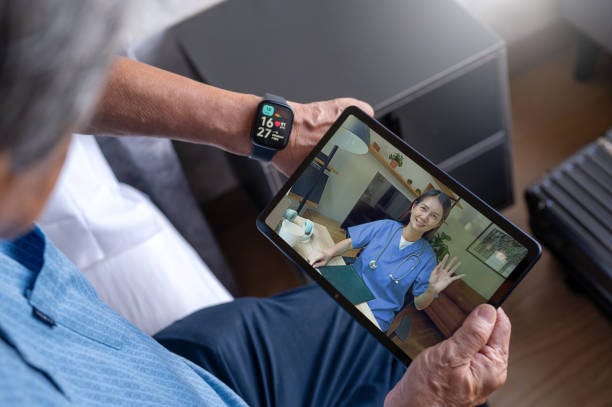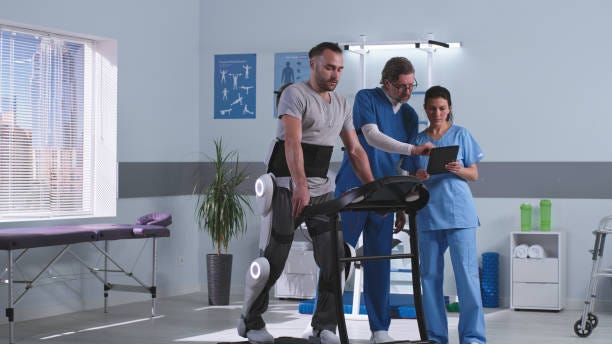Access, Innovation, Equity: Telemedicine as the Engine of Rehabilitation 4.0
The field of rehabilitation is undergoing a digital transformation globally, often described as “Rehabilitation 4.0.” This term evokes the principles of Industry 4.0 – personalization, precision, participatory engagement, and data-driven insights – applied to rehab care. Telemedicine has emerged as a cornerstone of this evolution, connecting patients with therapists and specialists remotely and augmenting traditional hands-on therapy with technology. The impetus for tele-rehabilitation’s rapid growth is clear: Globally, an estimated 2.4 billion people currently require rehabilitation services, a need that is only growing as populations age and chronic diseases become more prevalent. The COVID-19 pandemic further highlighted the necessity of new delivery models – in 2020, rehabilitation services were disrupted in 60–70% of countries due to lockdowns. In response, telehealth adoption accelerated exponentially, establishing telerehabilitation as a distinct sub-specialty of telehealth. Health leaders worldwide – from the World Health Organization (WHO) to national ministries – now recognize telemedicine as a critical strategy for expanding rehab access. In fact, the WHO’s Rehabilitation 2030 initiative explicitly underscores the importance of leveraging tele-rehab to reach patients who otherwise lack services. Against this backdrop, this article explores how telemedicine is reshaping rehabilitation across post-acute care, neurorehabilitation, and musculoskeletal recovery. We examine the key benefits of integrating telemedicine into rehab, the emerging innovations powering Rehabilitation 4.0, the workforce competencies required, market drivers and barriers, global program examples, alignment with Rehabilitation 4.0 principles, and the policy and investment steps needed to sustain this transformation.
Key Benefits of Integrating Telemedicine into Rehabilitation
Telemedicine is redefining where and how rehabilitation can occur, yielding numerous benefits for patients, providers, and health systems. Expanded access and convenience are primary advantages: Tele-rehab brings therapy to the patient instead of requiring travel to a clinic. This is invaluable for individuals in remote areas, those with mobility impairments, or communities lacking local specialists. Studies have found that tele-rehab can significantly reduce patient travel time and related costs – one review in low-resource settings showed a 40–60% reduction in travel expenses for patients using telerehabilitation, with adherence rates comparable to in-person sessions. By eliminating geographic barriers, telemedicine ensures that rural or underserved populations can receive continuous rehab support when they need it.
Another key benefit is continuity of care and safety. During the COVID-19 pandemic, tele-rehab enabled therapy to continue uninterrupted while minimizing infection risk. For example, the Centre for Neuro Skills (CNS) in the United States pivoted to telehealth in 2020, delivering over 90,000 hours of rehabilitation via telemedicine and reporting that a significant percentage of patients made the same or better progress as in-clinic patients. By keeping patients engaged in therapy from home, tele-rehab maintained recovery momentum in post-acute stroke care, brain injury rehabilitation, and post-surgical therapy at a time when in-person visits were limited. Many providers and patients have since recognized that tele-rehab can be highly effective, offering outcomes on par with traditional care while improving patient satisfaction through reduced travel and more flexible scheduling.
Telemedicine in rehab also supports multidisciplinary care and family involvement. Remote platforms make it easier to convene a team of specialists (physiatrists, physical therapists, occupational and speech therapists, psychologists, etc.) on a video call to coordinate on a patient’s care plan. Caregivers or family members can also join sessions virtually from anywhere, facilitating a participatory approach where the patient’s support network is involved in training and education. This aligns with rehab’s holistic, team-based ethos and ensures better carryover of exercises into the home environment. Additionally, tele-rehab often incorporates home environment assessments – therapists can observe the patient’s living situation via video and provide tailored recommendations (e.g. fall-proofing the home, ergonomic adjustments), something not easily done in clinic visits.
Crucially, tele-rehabilitation has proven to be cost-effective for health systems. By enabling more frequent but shorter touchpoints (e.g. quick video check-ins), it can catch complications early and prevent costly hospital readmissions. It also allows high-cost resources (like specialist consultations) to be leveraged more efficiently across distances. Research indicates telehealth broadly can improve efficiency without raising net costs, by reducing unnecessary ER visits and hospitalizations. In rehabilitation specifically, remote monitoring of patients’ progress can prompt timely interventions that avert relapses or secondary injuries. All these benefits – greater access, continuity, multidisciplinary reach, and cost savings – position telemedicine as a powerful tool to extend rehabilitation services to meet growing demands.
Emerging Innovations Transforming Tele-Rehabilitation
The integration of telemedicine into rehab is being supercharged by a wave of new technologies. Remote monitoring and wearable sensors now allow clinicians to keep an eye on patients’ functional status in real time beyond the clinic. Simple smartphone apps and wearable devices can track metrics like step counts, range of motion, heart rate, or exercise adherence. Research in tele-orthopedics and sports medicine shows that devices such as smartwatches, accelerometers, and motion sensors can be paired with telerehabilitation platforms to quantify patient movements and progress. For instance, a post-acute knee surgery patient might wear a knee sensor that streams range-of-motion data to their physical therapist, who can adjust the exercise program remotely based on objective recovery metrics. This data-driven remote monitoring augments the therapist’s ability to deliver precision rehab – making sure the patient is on track and catching any deviations early.
Artificial intelligence (AI) is further elevating tele-rehab through advanced assessment and personalization. AI-driven software can analyze patients’ performance on video or sensor data to detect subtle changes or compensatory movements that a clinician might miss over a grainy video feed. For example, computer vision algorithms using a laptop or phone camera can perform 3D pose estimation, allowing an AI to gauge if a stroke survivor is doing an arm exercise correctly or if a patient’s gait is improving symmetrically. These AI-based assessments provide objective, quantitative feedback to both patient and provider, supporting more precise adjustments in therapy. In emerging use cases, AI chatbots even guide patients through home exercises with real-time feedback, serving as a “virtual therapist” for basic coaching when live therapists are not available. While AI in rehab is still nascent, early studies suggest that integrating machine learning and big data analytics can create adaptive, patient-centered rehab programs that adjust difficulty or type of exercises automatically to a patient’s performance.
Perhaps the most futuristic innovation in Rehabilitation 4.0 is the concept of “digital twins” for patients. A digital twin is a virtual model of the patient – incorporating their anatomical, physiological, and functional data – that can be used to simulate rehabilitation scenarios. These AI-driven patient digital twins can integrate data from medical imaging, wearables, and electronic health records to create a personalized model of the patient’s abilities and limitations. When combined with telemedicine delivery, digital twins enable remote therapists to do things like: simulate how a patient might respond to a new exercise technique before trying it live, predict the patient’s recovery trajectory under different intervention plans, and objectively measure functional improvements in a virtual environment. Not only do digital twins support remote monitoring and virtual therapy sessions for patients in far-flung locations, but they also enhance accuracy – providing measurable indicators of functional recovery that take the guesswork out of assessments. Moreover, by pairing digital twin models with augmented or virtual reality (AR/VR) interfaces, rehabilitation exercises can be gamified and made more engaging. For example, a patient can perform balance exercises in a VR game, while the digital twin in the background analyzes their movements and provides real-time adjustments to the difficulty. This blend of AI, AR/VR, and telemedicine exemplifies the Rehabilitation 4.0 vision: highly personalized, tech-enabled therapy that can be delivered anytime, anywhere.
Virtual therapy and telerehabilitation platforms themselves continue to innovate. Beyond simple video calls, specialized tele-rehab software now incorporates interactive features such as digital exercise libraries, in-app progress tracking, and even virtual reality scenarios for therapy. Virtual reality (VR) in particular is gaining traction for neurorehabilitation and musculoskeletal recovery. VR-based rehab games – for instance, guiding a stroke patient through reaching tasks in a 3D game world – can improve engagement and adherence. Recent reviews noted that virtual reality interventions combined with telerehab have received positive outcomes, indicating they effectively supplement traditional therapy. As one example, during the COVID-19 period, some physical therapists used off-the-shelf apps and simple VR headsets to continue balance and gait training for patients at home, finding it helped maintain motivation. Robotics and haptic devices are another emerging area: a patient might have a robotic glove or exoskeleton at home to assist with exercises, which is controlled or monitored remotely by the therapist via telemedicine. All these innovations – from AI and digital twins to VR and robotics – are expanding the realm of what’s possible in remote rehabilitation, pushing the envelope towards more immersive, precise, and personalized tele-rehab experiences.
Building a Competent Tele-Rehab Workforce
To realize the full potential of telemedicine in rehab, we need more than just technology – we need a workforce trained to deliver tele-rehab effectively. Rehabilitation professionals (physiotherapists, occupational therapists, speech therapists, physiatrists, rehabilitation nurses, etc.) must develop new competencies on top of their clinical skills. Digital literacy and technical skills are fundamental: clinicians should be comfortable with teleconferencing tools, remote monitoring devices, and data management. Yet studies indicate that a lack of digital knowledge and experience is a barrier among many current rehab providers, especially those trained in eras before telehealth. Educational curricula are only beginning to catch up – telehealth (let alone telerehabilitation) has not been widely included in the training of health professionals in the past. This means that both in-service training and updates to university programs are needed so that therapists learn telehealth etiquette, remote assessment techniques, and virtual communication strategies as part of their professional development.
A core competency is the ability to conduct remote clinical assessments and interventions safely. Therapists must learn how to evaluate a patient’s range of motion, strength, balance, or speech via video and other tools, which can be challenging without physical contact. They need to master instructing and motivating patients through a screen, and ensuring patient safety (for instance, knowing how to guide a patient through an exercise remotely without risking a fall). This requires creative teaching methods – some training programs use simulation and role-playing where therapists practice tele-session scenarios. Communication skills are paramount: clinicians have to compensate for the lack of hands-on cues with clear verbal instructions and active listening. In one telerehab curriculum development, experts emphasized training providers to build rapport and trust virtually, manage technology glitches calmly, and uphold professional ethics in a tele-setting (e.g. privacy, informed consent).
Interdisciplinary collaboration and triage is another skill area. Since telemedicine can connect multiple specialists easily, rehab professionals should know how to function in virtual teams – referring patients appropriately, co-treating when needed, and using digital tools to communicate findings (like sharing screen for imaging results or progress dashboards). Additionally, working in tele-rehab often means being adept at patient education and self-management support. Therapists must coach patients (and their caregivers) to use equipment correctly at home, follow exercise regimens independently between tele-visits, and report any issues. This shifts more responsibility onto patients – a positive embodiment of the participatory care model, but it requires that providers are good at empowering and educating clients remotely.
Lastly, building a tele-rehab workforce requires addressing the digital divide among providers. Not all therapists may initially have access to high-quality internet, devices, or comfortable familiarity with technology. Investment in equipping clinics and community health centers with the needed infrastructure is part of the solution. In lower-resource environments, training might focus on leveraging whatever technology is available – even if it’s basic phone calls or SMS-based rehab coaching – to reach patients. For example, asynchronous methods like text messages and phone-based consultations can supplement care when video is not feasible. Ultimately, empowering the rehab workforce with telemedicine skills will ensure that technology is used appropriately and humanely – maintaining the compassionate, individualized approach that is the hallmark of rehabilitation, even when delivered through a screen.
Market Dynamics: Drivers and Barriers in Tele-Rehabilitation
The rise of telemedicine in rehabilitation is driven by powerful market forces – but it also faces notable barriers that stakeholders must navigate. On the demand side, demographic and epidemiological trends are creating urgent needs for scalable rehab solutions. Chief among these is the aging population worldwide. By 2050, the global population of people aged 60 and above is projected to reach 2.1 billion, an unprecedented number of older adults at high risk of chronic illnesses, injuries, and disabilities that require rehabilitation. Older individuals commonly face stroke, osteoarthritis, heart disease, Parkinson’s, and other conditions where rehabilitation is critical for maintaining function. At the same time, the prevalence of chronic diseases (such as diabetes, cardiovascular disease, cancer survivorship, chronic respiratory diseases, and obesity-related conditions) is climbing in many countries. Patients with these conditions often need long-term rehabilitative care to manage symptoms and prevent complications. As one market analysis noted, the growing burden of chronic disorders and geriatric conditions is fueling a surge in demand for rehab services globally. Health systems are recognizing that without new delivery models, the existing rehabilitation infrastructure (clinics, inpatient facilities, therapy staff) will be insufficient to serve all who need care. Tele-rehabilitation thus emerges as a key solution to scale rehab services efficiently and cost-effectively to meet this ballooning demand.
Another driver is the push for value-based care and cost efficiency. Payers and providers are increasingly incentivized to improve patient outcomes while controlling costs. Telehealth models have demonstrated potential to reduce overall spending by preventing adverse events and optimizing resource use. In rehabilitation, if telemedicine can keep patients out of hospitals (by managing issues proactively at home) and shorten or replace some in-person visits, it appeals to payers looking to reduce expensive post-acute care utilization. Furthermore, patient expectations and preferences in the digital age are shifting market dynamics – many patients appreciate the convenience of virtual services and may choose providers that offer tele-rehab options. The pandemic experience acclimatized millions to telehealth, and satisfaction levels have been high, which drives continued adoption.
On the other hand, significant barriers and challenges remain before tele-rehab can be universally integrated. Data privacy and security concerns are among the foremost barriers. Telemedicine encounters, by nature of being online, are more vulnerable to privacy and cybersecurity risks compared to face-to-face visits. Both patients and providers need confidence that health information transmitted during tele-rehab sessions (whether video, audio, or sensor data) remains confidential and secure. Any breaches or perceived risks can erode trust and lead to reluctance in using tele-rehab platforms. Ensuring compliance with data protection laws (like HIPAA in the US, GDPR in Europe, etc.) and implementing robust encryption and authentication measures is an ongoing imperative. Regulatory fragmentationalso poses a hurdle. The legal frameworks governing telehealth can vary widely across jurisdictions – even within one country, state or provincial licensure rules might restrict a therapist from treating a patient across state lines. Globally, some countries have well-defined telemedicine regulations while others are still evolving them. The rapid expansion of telehealth during COVID-19, paired with patchwork regulations, has created potential legal uncertainties and liability concerns for providers. For instance, clinicians must consider malpractice coverage for virtual practice and whether they are allowed to see patients who are physically located elsewhere. Harmonizing regulatory standards and licensure to accommodate telehealth is a complex but necessary step to avoid stunting the growth of cross-border or interstate tele-rehabilitation services.
Another barrier is the lack of reimbursement parity and sustainable funding models for tele-rehabilitation. In many healthcare systems, payment policies for telehealth lag behind. Rehabilitation services delivered remotely may not be reimbursed at the same rate (or at all) compared to in-person therapy, which discourages providers from adopting telemedicine beyond pilot programs. During the pandemic, emergency measures in some countries enabled temporary reimbursement for tele-physiotherapy or tele-consultations, but making those changes permanent requires policy action. Encouragingly, recent legislative initiatives in some regions have been advocating for expanded telehealth coverage and payment reform. For tele-rehab to scale, payers – both public and private – will need to recognize its value and incorporate it into standard benefit packages.
Other notable barriers include technology access and literacy issues (particularly for elderly patients who may struggle with devices or lack broadband internet), and resistance to change among certain providers or patients accustomed to traditional care. In low- and middle-income countries, these challenges are compounded by limited digital infrastructure. Connectivity issues and the cost of devices are major limiting factors in LMICs, meaning tele-rehab solutions must often be tailored to low-bandwidth or asynchronous formats. Despite these obstacles, the overall trajectory is toward growth. As tele-rehabilitation technologies prove their effectiveness and as success stories multiply, many of these barriers can be overcome through concerted efforts in policy, education, and technology design.
Global Examples: Tele-Rehabilitation in Practice Across Regions
Telemedicine-enabled rehabilitation is not just a phenomenon in wealthy countries – it is being implemented across diverse healthcare systems, from high-income nations to low-resource settings, albeit with different approaches. Here we highlight a few examples and programs that demonstrate the global reach of tele-rehab.
In high-income countries, tele-rehabilitation has quickly moved from experiment to mainstream in many places. The United States saw an explosion of tele-rehab services during the pandemic, and many providers have continued or expanded those services. We saw how the Centre for Neuro Skills in California delivered tens of thousands of hours of neurorehabilitation via telehealth. Large health systems and rehab hospitals (e.g. Mayo Clinic, Kaiser Permanente, the U.S. Veterans Health Administration) have since built tele-rehab into their care continuum – for example, providing stroke survivors with virtual physical and occupational therapy after hospital discharge, or running orthopedic post-surgery rehab classes via video. Patient outcomes in these programs have been closely monitored, and many report equivalent functional gains to traditional therapy, along with high patient satisfaction. In Europe, countries like Denmark and Norway – known for robust digital health infrastructure – have national tele-rehab portals that allow citizens to access physiotherapy exercises online, report progress, and consult with therapists remotely. Italy leveraged telemedicine for cardiac rehab and pulmonary rehab programs when COVID-19 closed clinics, later finding that remote cardiopulmonary rehabilitation maintained exercise capacity improvements in patients with heart and lung conditions. Australia and Canada have similarly embraced tele-rehab, especially to serve patients in vast rural areas. For instance, Australia’s Royal Flying Doctor Service piloted tele-physiotherapy to reach patients in the outback, and Canadian rehab centers have long used telehealth to connect therapists with patients in remote First Nations communities.
In low- and middle-income countries (LMICs), tele-rehabilitation is also making inroads, often through innovative, low-cost solutions. A narrative review of telerehab in LMICs found that even using basic technology can yield strong results: low-cost telerehab interventions significantly improved accessibility and clinical outcomes for patients with stroke, musculoskeletal disorders, and chronic pain in various LMIC contexts. These programs often leverage what is readily available – for example, WhatsApp or SMS-based therapy coaching, which has been used in parts of Africa and South Asia to deliver exercise instructions and health education. In India, physiotherapists have experimented with asynchronous video sharing: patients perform their exercises on video which they send via messaging apps, and therapists respond with feedback – a method that sidesteps the need for continuous high-bandwidth connections. Such approaches have helped overcome internet connectivity challenges in rural areas. A study from Bangladeshand Sri Lanka in spinal cord injury patients demonstrated that telerehab could alleviate patients’ sense of isolation, improve self-management, and achieve functional gains, even where resources were limited and solutions had to be highly affordable. In Latin America, countries like Brazil have begun integrating telehealth into community-based rehab. One example is in the state of Rio Grande do Sul, Brazil, where a telehealth initiative was used to bridge gaps in rehabilitation services for remote communities, aligning with the WHO’s Rehabilitation 2030 goals of universal access. While the technology used in LMIC tele-rehab might be simpler, the core principle is the same – use communications tools to connect patients with needed rehab expertise across distance.
These regional examples also highlight different implementation models. In some cases, tele-rehab is integrated into public health systems (as in parts of Europe, or pilot programs by ministries of health in LMICs). In other cases, private sector innovators and NGOs drive tele-rehab adoption by creating platforms and donating devices. For instance, an NGO in Kenya launched a telerehabilitation project providing tablets pre-loaded with rehab exercises to spinal injury patients in remote areas, demonstrating improved independence. Academic medical centers have played a role too, often partnering across borders (such as a U.S. university collaborating with a hospital in Uganda to train staff in teletherapy methods). What these programs across high and low-resource settings illustrate is that telemedicine in rehab is highly adaptable – it can be high-tech (with wearables and AI in a U.S. clinic) or low-tech (with text messages in a rural village), but in both cases the outcome is expanded reach of rehabilitation. Notably, across settings, patient acceptance of tele-rehab has generally been positive once they become familiar with it, and cultural barriers (like a preference for hands-on care) are gradually easing as success stories spread.
Aligning Telemedicine with the Goals of Rehabilitation 4.0
Rehabilitation 4.0 envisions a new era of rehab that is personalized, precise, participatory, and data-driven – telemedicine is a natural vehicle to drive these 4 P’s into practice. Personalization in rehab means tailoring therapy to the individual’s specific needs, characteristics, and goals. Telemedicine platforms facilitate this by gathering rich personal data and enabling one-to-one interactions unconstrained by location. Through remote monitoring and digital assessments, therapists can collect detailed information on how a patient is progressing in their daily environment, not just during clinic visits. This data helps in fine-tuning exercise programs to fit the patient’s real-life context. For example, if a patient’s wearable sensor shows their activity drops in the afternoons due to fatigue, the therapist can personalize the schedule or intensity of exercises accordingly. Moreover, AI-powered tools (like the digital twins discussed earlier) support personalization by simulating different rehab strategies and predicting which might work best for a given patient. The result is a shift away from one-size-fits-all protocols towards precision rehabilitation – delivering the right intervention, at the right time, in the right dose for each person.
Precision is further enhanced by telemedicine’s ability to continuously track outcomes and adjust course. In traditional rehab, a patient might be evaluated in person only once a week, whereas a tele-rehab model can involve daily check-ins or continuous sensor data. This constant feedback loop yields data-driven insights – trends and patterns in a patient’s performance can be analyzed to make evidence-based adjustments. In fact, digital rehab tools can increase the objectivity and accuracy of assessments by providing quantitative measures (e.g. exact degrees of joint motion or number of steps) rather than solely relying on subjective clinical observation. Telemedicine also allows for precision in access: patients can be matched with specialized providers who may not be locally available (for instance, a person with a rare neurological condition can receive expert consultation from a distant specialist via telehealth). This ensures people get precisely the expertise they need, when they need it.
Participatory care is a cornerstone of Rehabilitation 4.0, aligning closely with the ethos of patient-centered care. Telemedicine inherently invites a more active role for patients. By bringing rehabilitation into the home, patients (and their families) become co-creators of the therapy process. They must participate in setting up their environment for exercises, practice techniques on their own between virtual visits, and in many cases track and report their outcomes. Tele-rehab platforms often include patient portals where individuals can view their progress data, enter feedback, and communicate asynchronously with their care team. This transparency and engagement encourage patients to take ownership of their rehabilitation journey. Furthermore, telemedicine can facilitate peer support and group participatory models – for example, virtual group exercise classes or support groups for people with spinal cord injuries can connect individuals across geographic boundaries, allowing them to motivate and learn from one another. In essence, tele-rehab shifts some responsibility and knowledge to the patient, elevating them from a passive recipient of care to an active participant. This participatory approach has been linked to better adherence and outcomes, as patients who feel empowered are more likely to stick with rehabilitation long-term.
Finally, telemedicine enables data-driven insights on a scale previously unimaginable in rehabilitation. Every tele-rehab session, wearable sensor reading, AI analysis, or patient-reported outcome contributes to a growing pool of data. With appropriate privacy safeguards, aggregated data from tele-rehab programs can be mined (using AI and analytics) to discover what strategies work best for which conditions, to predict risks (like who is likely to drop out of therapy or who might have a fall), and to continuously improve protocols. Rehabilitation 4.0 is about leveraging such big data to refine care pathways. For instance, an analysis of thousands of telehealth stroke rehab sessions might reveal that patients who practice via tele-rehab within 2 weeks of hospital discharge recover arm function 20% faster – a data insight that could shape discharge planning policies. Telemedicine also integrates with precision health initiatives, where genomic and biometric data might be combined with rehab telemetry to truly personalize care. In summary, telemedicine is not merely a parallel way to do rehab; it actively enhances the personalization, precision, participation, and data-centric learningthat define the Rehabilitation 4.0 paradigm.
Policy, Reimbursement, and Investment for Sustainable Tele-Rehabilitation
To cement telemedicine’s role in rehab’s evolution, supportive policy frameworks, reimbursement strategies, and investment are essential. Policymakers must create enabling environments where tele-rehab is regulated in a way that ensures safety and quality without stifling innovation. Clear telehealth practice guidelines and licensure reciprocityagreements can help standardize care. Some progress is being made – for example, regional compacts in the United States allow licensed physical therapists to practice via telehealth across member states, and countries like Australia have issued national tele-rehab guidelines. The WHO’s call for “Rehabilitation 2030” encourages all countries to integrate rehabilitation into universal health coverage plans, and tele-rehab can be a means to achieve that if included in national health strategies. Regulatory modernization should also address privacy and security: updating health data laws to explicitly cover telehealth interactions, mandating interoperability standards so tele-rehab platforms can safely exchange data with electronic health records, and promoting accreditation or certification for tele-rehab services to assure quality. Importantly, international collaboration can help low-resource countries leapfrog by adopting telemedicine best practices and technologies shared by others, rather than each country reinventing the wheel. Global bodies and partnerships (e.g. WHO, World Federation of Occupational Therapists, telerehab research consortia) can facilitate this knowledge exchange.
On the reimbursement front, the mantra among advocates has been “payment parity” – ensuring that tele-rehabilitation services are reimbursed at levels comparable to in-person rehab when outcomes are equivalent. Insurers and national health payers need to recognize tele-rehab not as a luxury add-on, but as an integral modality of care delivery. Some encouraging developments occurred during COVID-19, when insurers began covering tele-physiotherapy sessions out of necessity. The task now is making those changes permanent and expanding coverage. Innovative reimbursement models could further boost tele-rehab; for example, bundled payments or value-based payments that reward providers for patient outcomes regardless of modality would encourage the most efficient mix of in-person and telehealth rehab. Policymakers can also incentivize tele-rehab in underserved areas by increasing reimbursement rates for providers who see patients in rural or low-income communities via telehealth (to offset initial technology costs). Moreover, integrating tele-rehab into employer health plans and workers’ compensation (for on-the-job injuries) can drive demand by making it a standard option.
Significant investment is needed to scale tele-rehabilitation sustainably. This includes investment in technology infrastructure – expanding broadband internet access (especially in rural and low-income urban areas) so that more patients and clinics can utilize telehealth. It also means investing in platforms and tools: governments and health systems might subsidize the development or licensing of user-friendly tele-rehab software, perhaps creating public platforms that smaller clinics can use. Funding for research and innovation is equally important; continued R&D will improve tele-rehab technologies (e.g. more AI-driven assessments, better low-bandwidth solutions, culturally adapted digital content for diverse populations). Workforce development investment, as discussed, will pay off by creating a cadre of telehealth-proficient rehab professionals. Donors and international aid organizations are increasingly viewing assistive technology and telehealth as areas worthy of support – for instance, the World Bank and other donors could fund tele-rehab pilot programs as part of larger health system strengthening in LMICs.
Finally, sustainability will depend on demonstrating and communicating the value of tele-rehabilitation. Policymakers and payers respond to data, so collecting outcomes and economic data from tele-rehab programs is crucial. If we can show that a tele-rehab program for heart failure patients reduces hospital readmissions by X% or that a telestroke rehab initiative yields return-to-work rates higher than usual care, it builds the business case to continue funding these services. Early evidence is promising: many studies and pilots have already reported high effectiveness and patient satisfaction with tele-rehab, as well as cost savings from reduced travel and optimized care delivery. Sharing these success metrics with stakeholders will help secure the needed buy-in. In addition, developing public-private partnerships can accelerate scaling – for instance, a government could partner with a tech company to provide tele-rehab kits (tablets and sensors) to community health centers, combining public funding with private innovation.
Telemedicine is shaping the future of rehabilitation on a global scale, breaking down the walls of traditional therapy and aligning perfectly with the vision of Rehabilitation 4.0. By delivering personalized, precise, participatory, and data-driven rehab services, telemedicine technologies are transforming post-acute recovery, neurorehabilitation, and musculoskeletal care. The benefits – from greater access and cost-effectiveness to innovative therapy modalities – are compelling, and emerging innovations promise to further enhance outcomes. Yet realizing this potential everywhere requires training a workforce ready for digital practice, addressing privacy and regulatory hurdles, and investing in infrastructure and payment systems that support tele-rehab. The momentum is building: aging populations and chronic disease burdens make the status quo untenable, and tele-rehabilitation offers a path to expand capacity without compromising quality. Whether it’s a stroke survivor in a major city using an AI-powered rehab app, or a paraplegic patient in a rural village receiving guidance via a basic phone, telemedicine is enabling rehabilitation to reach those who need it most, wherever they are. For policymakers, health system leaders, and digital health innovators, the charge is to collaborate in scaling these solutions responsibly and inclusively. By doing so, we can ensure that the next generation of rehabilitation – Rehab 4.0 – delivers on its promise of a healthier, more equitable world where everyone who needs rehab can get it, on their own terms.
Stay informed of these developments via my LinkedIn updates at https://www.linkedin.com/in/zenkoh/ and subscribe to my newsletter at
Legal Disclaimer
This article is intended for informational purposes only and does not constitute professional advice. The content is based on publicly available information and should not be used as a basis for investment, business or strategic decisions. Readers are encouraged to conduct their own research and consult professionals before taking action. The author and publisher disclaim any liability for actions taken based on this content.













